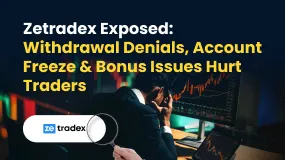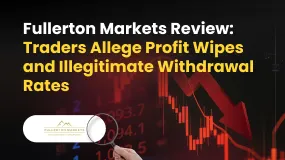简体中文
繁體中文
English
Pусский
日本語
ภาษาไทย
Tiếng Việt
Bahasa Indonesia
Español
हिन्दी
Filippiiniläinen
Français
Deutsch
Português
Türkçe
한국어
العربية
Popular Terms In Forex Trading You Should Know
Abstract:First, you must master the fundamentals of foreign exchange. Foreign exchange, commonly known as Forex and FX, is the conversion of one currency into another, such as EUR/USD (Euro - US Dollar), USD/JPY (US Dollar - Japanese Yen), and GBP/USD (British Pound - US Dollar).

Understanding the trends and common words used in the Forex market is a crucial step toward smart and profitable trading.
Continue reading if you want to stay up to speed on important Forex terms that will assist you with your trading.
First, you must master the fundamentals of foreign exchange. Foreign exchange, commonly known as Forex and FX, is the conversion of one currency into another, such as EUR/USD (Euro - US Dollar), USD/JPY (US Dollar - Japanese Yen), and GBP/USD (British Pound - US Dollar). Unfortunately, it is not always so simple and may be pretty complicated at times. As a result, before contemplating trading currency pairings, you should get acquainted with some of the frequent words used in the field of FX. The first step in developing your trading strategy is to understand these concepts.

Basic Forex Terminology
Here is a list of common terminology used in the forex trading industry:
Pip - The smallest and most common increment in which a currency pair is valued. Pips are used to gauge the movement of a currency pair. Pips pricing are subject to vary and may be influenced by the date of the transaction as well as the quantity transacted.
Bid - The price at which the market maker/broker want to purchase the currency pair. The Bid price is affected by the value of the underlying currency pair.
Ask - The price at which the market maker/broker is willing to sell the currency pair is known as the ask. It is also determined by the underlying currency pair's value.
Spread - The difference in Buy/Sell (Bid/Ask) prices provided to traders on the trading platform. When a CFD provider has lower spreads than its rivals, traders benefit from a smaller gap between the Buy and Sell prices of the underlying FX trading pair. Market liquidity may be measured using spread.
Based - The initial currency in a currency pair, also known as the nominator (or top number). When trading the USD/CAD pair, for example, the USD is the base currency.
Quote - The second currency in a currency pair is also known as the denominator (or bottom number), hence the CAD is termed the Quote when trading USD/CAD.
Leverage - The ability to obtain exposure to higher quantities of currency without having to pay the whole worth of your deal up front. It enables you to trade bigger sums with less cash. For example, a leverage of 1:50 implies you might use a $200 opening margin to initiate a $10,000 transaction. Leverage may greatly increase your earnings, but it can also greatly increase your losses.
Trading Terms in the Market
Aside from Forex, the market is a complicated realm consisting of innumerable words that traders must be aware with in order to make the best trading decisions possible. As a result, to assist you comprehend the numerous ideas and technical phrases, we've produced a list of the key market terms to remember below:
Bear Market - A bear market is one in which traders anticipate prices to decrease, implying that there will be more short selling (or traders 'going short').
Bull Market - A bull market is one in which the market is rising and traders are anxious to enhance their long trading activity (also known as “going long”). For example, in 2022, NVIDIA entered a bullish market and its value increased, causing many traders to buy its stock.
Broker – A middleman through whom traders and financial institutions execute deals.
Federal Reserve - The Federal Reserve is the United States' official centralized bank in charge of regulating economic activities. The Fed is sometimes shortened as the 'Fed.' The Federal Reserve's goal is to keep inflation under control through influencing interest rates. When inflation becomes excessive, the Federal Reserve normally boosts interest rates in order to slow the economy and reduce inflation.
GDP (Gross Domestic Product) - The entire amount of a country's economic activity, which reflects the overall health of its economy.
Inflation - The rate at which the price of goods and services increases in a national/state economy. Inflation rates may impact the value of Forex pairs and other traded assets by reducing or increasing their value.
Foreign Exchange Volatility - Foreign exchange volatility refers to a market's price swings. The more the price changes, the more volatile a market is thought to be. In other words, it measures how volatile/unpredictable its price movement may be. This is a good measure of how hazardous a currency pair is to trade.
Interest Rates - The interest rates paid by a bank or credit provider for lending money. In general, central banks manage interest rate levels, which are crucial to a currency's strength or weakness. Interest rates may influence currency prices in the sense that, for example, the US dollar tends to gain when interest rates rise and the Fed reduces supply. When trading a certain currency pair, forex traders should be informed of how each nation determines its interest rates, since each currency has distinct interest rates established by various central banks.

The Federal Funds rate determines the interest rate on the US currency.
The Euro Interbank Offered Rate determines the value of the Euro (EURIBOR).
The GBP is tracked by the Sterling Overnight Index Average (SONIA).
The CHF is based on the Swiss Reference Rates (SARON).
The JPY is based on the Tokyo Interbank Offered Rate (TIBOR).
Reports and Indicators
It is essential to consult chart indicators and economic news in order to maximize market fluctuations and predict your next trading move. Economic data and chart indicators may have an influence on numerous assets such as currencies and commodities. On the Plus500 site, you can discover all of the main data releases on the economic calendar, as well as a variety of graphing tools. Here are the most important ones to be aware of:
RSI (Relative Strength Index) - RSI is a technical indicator that indicates if an asset is overbought or oversold over a two-week period. It has a scale of 1 to 100. The RSI indicates the historical and current strength or weakness of an underlying asset.
CCI (Commodity Channel Index) - Is a statistical variance from a set average ranging from -100 to +100. CCI is used to monitor market extremes and trends.
MACD (Moving Average Convergence/Divergence) - is a technical trading indicator that detects moving averages and aids in the representation of possible new upward/downward market movements. The MACD indicator is used to identify probable overbought or oversold market patterns.
Correlation - the reciprocal connection between two assets that indicates how similar (or unlike) they are. Correlations vary from +1 to -1.
CPI (Consumer Price Index) - is a standard inflation statistic used to monitor the cost of goods and services. It may also be used to monitor monetary fluctuations, inflation, and earnings and salaries, and is often calculated monthly.
The PMI (Purchasing Managers Index) - measures the relative strength of the manufacturing and services industries. The PMI is used to categorize market conditions as growing, falling, or stable, therefore representing current and future volatility.
QE (Quantitative easing) - is the technique of pumping money into the market to assist the overall economy in avoiding a recession. QE is used by central banks such as the Federal Reserve to lower interest rates and make loans more accessible to borrowers.
Additional Forex Terminology
Aside from the Forex terms discussed above, the list below includes the most common terms found on trading platforms. Knowing these phrases might be beneficial to your trading, particularly if you want to develop a trading plan.
Stop Loss Order - a market order used to terminate a losing trade when it reaches a certain threshold.
A Clost at Profit Order - is a market order that is used to close a lucrative position when it reaches a specified level.
Fundamental Analysis - predicts how a currency pair will move based on broader economic and political factors. Traders that employ this form of analysis often assess the implications of bigger economic developments on the value of currency pairings.
Technical Analysis uses chart patterns (previous performance) to determine which direction a currency pair will move next.
Major Pairings (or Majors) - A list of the world's most traded currency pairs. They account for the majority of the foreign currency market and are all priced and traded against the USD, including the EUR/USD, GBP/USD, USD/CHF, and USD/JPY.
Minor Pairings (or Minors) - Currency pairs that are not as liquid or extensively traded as the Majors. Exotic currencies, such as the AUD/JPY, are sometimes referred to as such.
Cross Currency Pairs or (Crosses) - Currency pairings that do not include the USD are known as cross currency pairs (or crosses). Euro to Pound (EUR/GBP), Euro to Swiss Franc (EUR/CHF), and Australian Dollar to Japanese Yen (AUD/JPY) are popular cross rates.
Finally, these are just a few of the fundamental terminology you should be familiar with before trading Forex currency pairings. There are many more, and some will be more important to you than others; it all depends on the currencies you wish to deal with and the sorts of trades you are carrying out.
Keep an eye out for updates.
WikiFX App may be downloaded through the App Store or the Google Play Store.

Disclaimer:
The views in this article only represent the author's personal views, and do not constitute investment advice on this platform. This platform does not guarantee the accuracy, completeness and timeliness of the information in the article, and will not be liable for any loss caused by the use of or reliance on the information in the article.
Read more

Is Fyntura a Regulated Broker? A Complete 2025 Broker Review
Fyntura is a broker accused by many users of posting fake reviews and running paid promotions with influencers to attract unsuspecting traders. Several users have faced withdrawal issues, blocked accounts, and manipulated trades. These are the real complaints and experiences shared by traders online. In this latest Fyntura Review 2025, you’ll learn about genuine user feedback, reported issues, and the broker’s credibility helping you make a better trading decision.

Zetradex Exposed: Withdrawal Denials, Account Freeze & Bonus Issues Hurt Traders
Do you constantly face withdrawal denials by Zetradex? Does the forex broker keep freezing your account and wiping out your capital? Have you also undergone issues concerning the Zetradex no deposit bonus? These trading issues have become apparent as the forex broker allegedly scams traders all over. In this Zetradex review article, we have demonstrated some complaints. Read them to get a feel of what happens to traders here.

Fullerton Markets Review: Traders Allege Profit Wipes and Illegitimate Withdrawal Rates
Have you witnessed constant profit deletion from Fullerton Markets? Has the Saint Vincent and the Grenadines-based forex broker wiped out all your capital after you checked it on Fullerton Markets Login? Do you find the deposit and withdrawal rates abnormal here? These complaints have been grabbing everyone’s attention on Fullerton Markets Review Platforms. In this article, we have shared some of these complaints for you to look at and inspect. Read on!

Axi Plaza Redefines Cam Ranh’s Beachfront Business Scene
Axi Plaza launches on Cam Ranh’s coast, merging resort, retail, and MICE spaces in one destination, shaping Vietnam’s tourism future.
WikiFX Broker
Latest News
BASF CEO: EU CO₂ Trading Is A "Destruction Mechanism" For European Industry
PINAKINE Broker India Review 2025: A Complete Guide to Safety and Services
Is Inzo Broker Safe or a Scam? An Evidence-Based Analysis for Traders
Is Uniglobe Markets Legit? A 2025 Simple Guide to Its Safety, Services, and User Warnings
Is Forex Zone Trading Regulated and Licensed?
WikiEXPO Dubai 2025 “Welcome Party” Kicks Off Tonight!
He Trusted a WhatsApp Group and Lost RM659,000
Exness Restricted Countries List 2025 Explained
Zetradex Exposed: Withdrawal Denials, Account Freeze & Bonus Issues Hurt Traders
Capital.com Review 2025: Is It a Scam? Official License Verification and Real User Ratings
Currency Calculator




